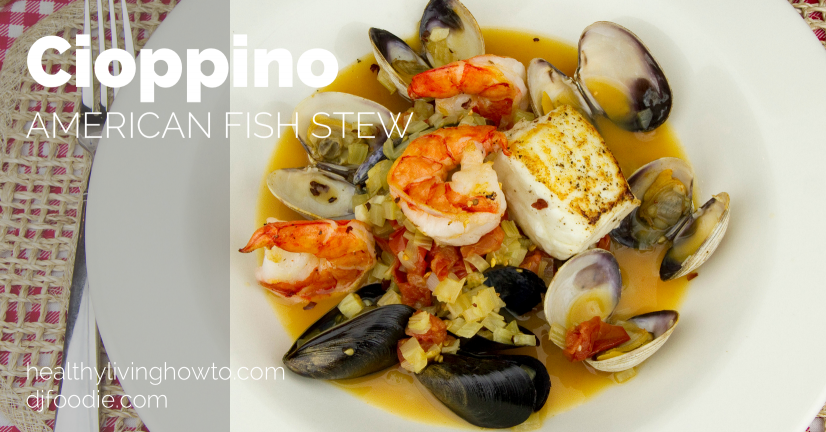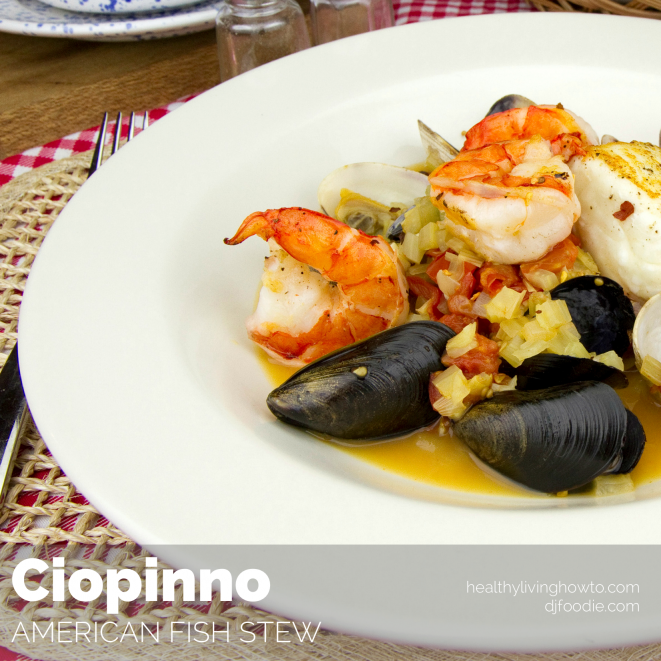I often feel the US has no real “indigenous” foods. Walk into a Thai restaurant and you know what you’re likely to find on a menu. The same would be true of an Ethiopian, Mexican, Italian or Japanese restaurant. What can you expect, walking into an American restaurant? Hot dogs and hamburgers? Yep, probably. These, while being of German descent, have been appropriated by the US and are now probably the closest thing to a true American food that you’d find short of perhaps a Venti Latte.
Well, ok, maybe not, Cajun and Creole foods, while certainly having significant influence from Europe, Africa and the Indignous people of the South East United States, it’s very clearly an American food.
Cioppino, in much the same way, is an American stew. It’s heavily Italian, with the name stemming from a north-east Italian word meaning “to chop”. This stew, born in San Francisco about 150 years ago, was the creation of an Italian fish wholesaler named “Achille Paladini”, later dubbed “The Fish King” by The Little Mermaid, Dory and Nemo.
A true Cioppino (pronounced CHUH-PEE-NO) is made from super fresh seafood, but unwanted and leftover seafood, meaning crabs missing legs, lobster sans claws, small unwanted shrimps and clams that may or may not ever open. It’s all fresh and “catch of the day”, but is akin to the meager late night selection offered at the local grocery store, as opposed to the fresh bounty found in the morning. These super fresh scraps were tossed, bones, shells and all, into a bubbling hot cauldron of tomatoes, wine, garlic, and other aromatics like herbs and lemon.
Growing up, my family would visit San Francisco about thrice a year. It was a 4-hour drive, and it seemed to always result in a trip to the wharf, where we’d see wax museums, small bizarre rides, chocolate factories, the Sharper Image store and seafood restaurants, where my father would bib up and order a giant bowl of Cioppino. Watching sea lions at the wharf was my visit to the mid-80’s San Francisco Waterfront, Cioppino was my father’s.
With 25 years of professional culinary experience, one of my fondest early creations is Cioppino. Knowing it was my father’s favorite, I set out to recreate the best. I’d find the best sea foods. I’d go to farmer’s markets to find the best ingredients. I’d read through family cookbooks to try and procure the best recipes. Then I’d make it. I made it old school, too. I used squid and shrimp and crabs with claws. A bit spicy from peppers, a bit tart from the wine and lemon, with a touch of sweet coming from the onions and garlic, but oh the pungent salt coming from the bivalves and the funk coming from the mustard within the crustaceans. What an amazing mélange it was.
While I can appreciate what slow heat and mellow time can do to a bowl of acidic seafood, I’ve also acquired a taste for raw scallops and medium rare shrimps. I love the vibrancy of super fresh herbs, with their aromas just being released by the heat. Truth be told, my palate has changed and I tend to prefer fresh vibrancy over broken down stew.
This recipe, as presented, is actually a quick or “Haste Cioppino” potentially even referred to as a “Lazy Cioppino”, because it’s been shelled, beheaded and made easy to eat. Bib not required!
Ingredients
- 1/2 c. Butter, melted and divided
- 1 c. White Wine
- 1 Small Onion, peeled and diced
- 4 Garlic Cloves, minced
- 2 Medium Tomatoes, diced
- 1 Small Bulb Fennel, diced
- 2 Ribs Celery, diced
- 1/2 tsp. Chili Flakes
- 1 Bay Leaf
- 32 Medium-Sized Clams, fresh and alive
- 32 Medium-Sized Mussels, fresh and alive
- 1 lb. Shrimp
- 1 1/2 lb. Halibut Fillets
- Juice of One Lemon
- 1 tsp. Fresh Thyme, chopped
- 1/2 tsp. Fresh Lemon Zest
Directions
- In a large pot, add 1/2 cup butter, wine, onion, garlic, tomato, fennel, celery, chili flakes and bay leaf, with a little salt and pepper. Put it on the stove over medium-low heat with a lid and allow it to simmer. Allow it to simmer for about 20 minutes.
- While the broth simmers, soak the clams and mussels in a bowl of cold water, with a slow, steady stream of cold water dropping from the faucet into the bowl. This helps remove a touch of extra saltiness and sand. Let this sit with the water dripping on it.
- Pick clams and mussels out of the bowl by scooping them up with your hands, and transferring them to another bowl. Any sand or debris should be left at the bottom of the original bowl.
- Wash the original bowl and set aside. We'll use it one more time. Place the new bowl of clams and mussels under the slow stream of cold water.
- Peel shrimp and remove the big vein running through the back.
- Cut your fish into appropriate sizes. Large bite sized chunks is fine, but I opted for larger fillets. I thought it looked nicer when it was in the bowl.
- Transfer your clams and mussels one more time. With a wet towel, pull the beards from the mussels. This is done by grabbing the beard with the towel and pinching hard between your fingers, then deliberately pulling out and towards the hinge. Some come out easier than others, but this should just about do it. You may also want to scrub the outside of your mussel shells, if there are a lot of funky little barnacles, debris and other riddles and games attached to them. Once your clams and mussels are clean and happy, pull them up and out of the bowl and place them on a dry towel, or in a colander to drip dry.
- Place a large sauté pan on the stove over high heat.
- Season your thick halibut fillets with salt and pepper. Also coat them with butter. Place them in your hot sauté pan and get a nice brown color on one side. When the first side has color, turn the fish over and sear the other side.
- When the second side of halibut has a nice sear, add your clams and mussels to the pan and shake everything around. Let sit for 30 seconds and then dump the halibut, clams and mussels into the pot with the broth. Place the lid on the pot and allow it to continue simmering.
- While that simmers, quickly clean out your hot sauté pan and keep it hot on high heat.
- Season shrimp with salt and pepper. Coat them with butter and place into the hot sauté pan to get a little color. Once one side sears, flip them over and sear the other side. Once both sides are seared, add them to the pot with the broth.
- Sprinkle the lemon juice, lemon zest and fresh thyme over the top of the ingredients in the pot and give it a quick stir. Replace the lid and allow the whole pot to simmer for about 3 to 4 more minutes. From the moment you started searing your halibut, to the moment the Cioppino is added to the bowls, should be about 12 minutes. It goes quickly!
- Evenly divide your Cioppino into bowls and serve!

